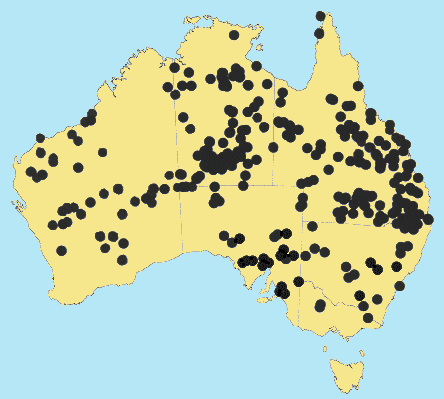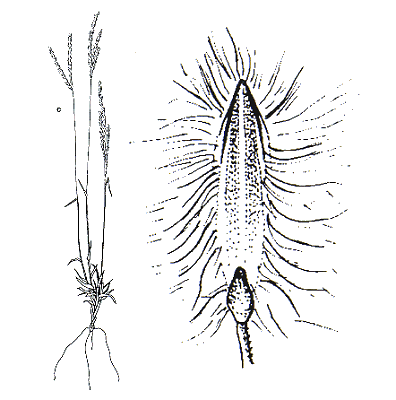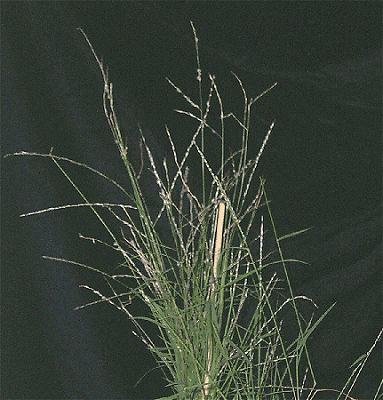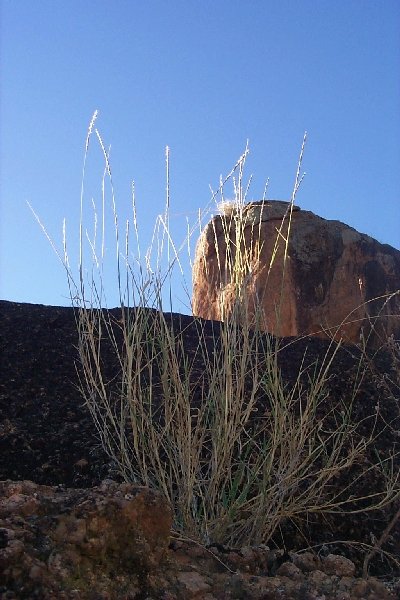Digitaria brownii (Roem. & Schult.) D. K. Hughes. Bull. Misc. Inform. 313 (1923).
Classification. (GPWG 2001) : Subfamily Panicoideae. Paniceae.
Basionym and/or Replacement Name: Panicum villosum R. Br. Prodr. 192 (1810), non Lam. (1791).
Recent synonyms: D. brownii var. monostachya.
Key references (books and floras): [1810]. R.Brown, Prodromus (192 as Panicum villosum), [1878] G.Bentham, Flora Australiensis 7 (472 as Panicum leucophoeum), [1952] C.A.Gardner, Flora of Western Australia 1 Gramineae (227), [1981] M.Lazarides in J.Jessop (ed)., Flora of Central Australia (473), [2002] D.Sharp & B.K.Simon, AusGrass, Grasses of Australia, [2006] J.Jessop, G.R.M.Dashorst, F.M.James, Grasses of South Australia (438), [2008] S.W.L.Jacobs, R.D.B.Walley & D.J.B.Wheeler, Grasses of New South Wales (214).
Illustrations: [2006] J.Jessop, G.R.M.Dashorst, F.M.James, Grasses of South Australia (439, Fig. 369), [2008] S.W.L.Jacobs, R.D.B.Whalley & D.J.B.Wheeler, Grasses of New South Wales, 4th edn (214).
Habit. Perennial. Rhizomes present, elongated. Stolons absent. Culms erect or geniculately ascending, 30–100 cm tall, 5–15 -noded. Mid-culm internodes glabrous. Mid-culm nodes glabrous. Lateral branches sparsely branched. Leaf-sheaths glabrous on surface or hairy. Leaf-sheath auricles absent, or present. Ligule an eciliate membrane, 1–2 mm long, truncate. Leaf-blades flat, 3–12 cm long, 0.5–7 mm wide. Leaf-blade surface scaberulous or scabrous, glabrous or indumented.
Inflorescence. Inflorescence compound or subdigitate, a panicle of racemes, with racemose branches. Racemes 1–7, 5–18 cm long. Central inflorescence axis 1–3(–6) cm long.
Spikelets. Spikelets pedicelled, 2 in the cluster. Fertile spikelets 2-flowered, the lower floret barren (rarely male), the upper fertile, comprising 1 basal sterile florets, comprising 1 fertile floret(s), without rachilla extension, lanceolate or ovate, dorsally compressed, 2.6–3.5 mm long. Rhachilla internodes elongated between glumes.
Glumes. Lower glume ovate, 1 -nerved. Upper glume elliptic, 2.2–3.5 mm long, membranous, 3 -nerved. Upper glume surface indumented. Florets. Basal sterile florets 1, barren, without significant palea. Lemma of lower sterile floret 100 % of length of spikelet, membranous, 5–7 -nerved.
Fertile lemma 2.2–3.1 mm long, without keel, 3 -nerved. Lodicules present. Anthers 3.
Continental Distribution: Australasia.
Australian Distribution: Western Australia, Northern Territory, South Australia, Queensland, New South Wales, Victoria.
Western Australia: Gardner. Giles, Fortescue. Northern Territory: Darwin & Gulf, Victoria River, Barkly Tableland, Central Australia North, Central Australia South. South Australia: North-western, Lake Eyre, Gairdner-Torrens Basin, Flinders Ranges, Eastern, Eyre Peninsula, Murray, Southern Lofty. Queensland: Burke, Burnett, Cook, Darling Downs, Gregory North, Leichhardt, Maranoa, Mitchell, Moreton, North Kennedy, Port Curtis, South Kennedy, Warrego, Gregory South. New South Wales: North Coast, Central Coast, Northern Tablelands, Southern Tablelands, North-Western Slopes, Central-Western Slopes, South-Western Slopes, North-Western Plains, South-Western Plains, North Far Western Plains, South Far Western Plains. Victoria: East Gippsland, Midlands, Riverina, Wimmera.
Notes. In tropical and subtropical wet sclerophyll forests, temperate wet sclerophyll forests, dry sclerophyll forests, Brigalow forests, tropical and subtropical sub-humid woodlands, semi-arid shrub woodlands, arid and semi-arid low woodlands, shrub steppe shrublands, acacia shrublands, arid tussock grasslands, arid hummock grasslands, and temperate sub-humid grasslands. A variable species with wide distribution. Flowers sporadically throughout the year.






